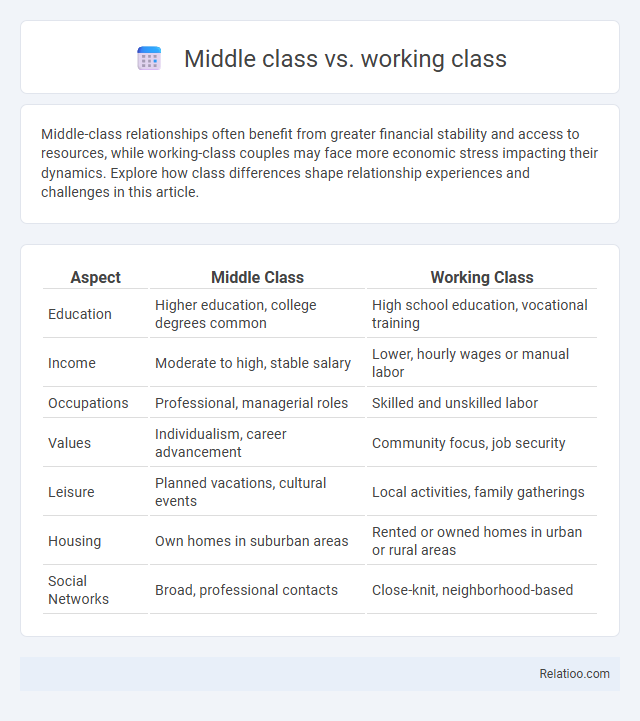Middle-class relationships often benefit from greater financial stability and access to resources, while working-class couples may face more economic stress impacting their dynamics. Explore how class differences shape relationship experiences and challenges in this article.
Table of Comparison
| Aspect | Middle Class | Working Class |
|---|---|---|
| Education | Higher education, college degrees common | High school education, vocational training |
| Income | Moderate to high, stable salary | Lower, hourly wages or manual labor |
| Occupations | Professional, managerial roles | Skilled and unskilled labor |
| Values | Individualism, career advancement | Community focus, job security |
| Leisure | Planned vacations, cultural events | Local activities, family gatherings |
| Housing | Own homes in suburban areas | Rented or owned homes in urban or rural areas |
| Social Networks | Broad, professional contacts | Close-knit, neighborhood-based |
Defining the Middle Class and Working Class
The middle class typically consists of individuals with moderate income levels, stable employment, and access to education or professional jobs, distinguishing them from the working class, which often includes manual laborers or service workers with lower wages and less job security. Class difference arises from disparities in income, education, occupational roles, and lifestyle choices, which influence social mobility and economic stability. Your understanding of these classes can help identify economic opportunities and challenges relevant to your personal or community context.
Historical Evolution of Social Classes
The historical evolution of social classes reveals distinct changes in the middle class and working class driven by industrialization and economic development. The working class emerged prominently during the Industrial Revolution, characterized by manual labor and factory work, while the middle class expanded through professional, managerial, and entrepreneurial roles. Class differences intensified with wealth accumulation, education access, and social mobility opportunities, shaping modern socioeconomic structures.
Income Levels: Key Indicators and Differences
Income levels serve as primary indicators distinguishing middle class from working class, with middle class households typically earning between $50,000 and $150,000 annually, while working class incomes generally range from $25,000 to $50,000. Key differences include job security, access to benefits, and disposable income, where middle class individuals often enjoy greater financial stability and capacity for savings compared to working class counterparts. Class differences also manifest in investment opportunities, educational attainment, and economic mobility, shaping long-term wealth accumulation and quality of life.
Education and Career Opportunities
Education significantly shapes the divide between middle class and working class individuals, as middle class families often have access to better schools, advanced degrees, and professional networks that lead to higher-paying, stable careers. Working class members frequently face limited educational resources and vocational training, restricting their career opportunities to lower-wage, manual, or service jobs with less upward mobility. Your career prospects and economic stability are deeply influenced by these class-based disparities in educational attainment and access to professional development.
Lifestyle and Consumption Patterns
Middle class lifestyles often feature stable incomes allowing for discretionary spending on education, entertainment, and homeownership, while working class consumption focuses on meeting essential needs with limited savings for luxury or leisure. Class differences manifest in access to quality healthcare, recreational activities, and technology, influencing long-term financial security and social mobility. Your consumption patterns reflect these disparities, as middle class households typically invest in brand-name goods and experiences, whereas working class individuals prioritize affordability and practicality.
Home Ownership and Living Standards
Home ownership significantly varies between the middle and working classes, with the middle class more likely to afford stable, quality housing, reflecting higher living standards and financial security. The working class often faces barriers such as lower income and limited access to affordable credit, resulting in lower home ownership rates and more transient living conditions. Your ability to build wealth through property is strongly influenced by these class differences, impacting long-term economic stability and quality of life.
Social Mobility Between Classes
Social mobility between the middle class and working class depends on factors such as education level, job opportunities, and economic stability. Your ability to move between classes is often influenced by access to resources, social networks, and government policies supporting economic advancement. Class difference creates varying barriers and opportunities that shape the potential for upward or downward mobility within society.
Impact of Economic Policies
Economic policies such as tax reforms, minimum wage laws, and social welfare programs significantly affect middle and working-class financial stability and upward mobility. Middle-class households often benefit from policies promoting homeownership and education subsidies, while working-class groups rely more on labor protections and direct income support. Class differences widen when economic policies favor capital accumulation over wage growth, intensifying income inequality and limiting opportunities for working-class advancement.
Cultural Values and Social Identity
Cultural values deeply influence the social identity of middle and working-class groups, with the middle class often emphasizing education, self-improvement, and future-oriented goals, while the working class may prioritize loyalty, tradition, and community cohesion. These differences shape your worldview, social interactions, and even aspirations, reinforcing class distinctions through habits, language, and social networks. Understanding how these cultural frameworks define each class helps reveal the nuanced class differences beyond economic status alone.
Future Trends in Class Distinction
Future trends in class distinction reveal a growing divergence between the middle class and working class driven by technology, education access, and automation. The middle class is expected to benefit from increased digital skill demands and higher education opportunities, while the working class faces job displacement in traditional sectors due to automation and AI integration. Economic mobility may become more constrained as wealth concentration intensifies, solidifying class boundaries and reshaping consumption patterns and political influence.

Infographic: Middle class vs Working class
 relatioo.com
relatioo.com